Ex 13.1 Class 9 Maths Question 1.
A plastic box 1.5 m long, 1.25 m wide and 65 cm deep is to be made. It is opened at the top. Ignoring the thickness of the plastic sheet, determine
(i) The area of the sheet required for making the box.
(ii) The cost of sheet for it, if a sheet measuring 1m2 costs ₹20.
Solution:
(i) Here, length (l) = 1.5 m, bread th(b) = 1 .25 m
and height (h) = 65 cm = 65100 m = 0.65 m

∵ It is open from the top.
∴ Its surface area
[Lateral surface area] + [Base area]
[2(1 + b)h] + [lb]
= [2(1.50 + 1.25)0.65] m2 + [1.50 x 1.25] m2
= [2 x 2.75 x 0.65] m2 + [1.875] m2
= 3.575 m2+ 1.875 m2 = 5.45 m2
∴ Area of the sheet required for making the box = 5.45 m2
(ii) Cost of 1 m2 sheet = Rs. 20
Cost of 5.45 m2 sheet = Rs. (20 x 5.45)
= Rs. 109
Hence, cost of the required sheet = Rs. 109
Ex 13.1 Class 9 Maths Question 2.
The length, breadth and height of a room are 5 m, 4 m and 3 m, respectively. Find the cost of white washing the walls of the room and the ceiling at the rate of ₹17.50 per m2.
Solution:
Length of the room (l) = 5 m
Breadth of the room (b) = 4 m
Height of the room (h) = 3 m
The room is like a cuboid whose four walls (lateral surface) and ceiling are to be white washed.
∴ Area for white washing
[Lateral surface area] + [Area of the ceiling]
[2(l + b)h] + [l x b]
= [2(5 + 4) x 3] m2 + [5 x 4] m2 = 54 m2 + 20 m2 = 74 m2
Cost of white washing for 1 m2 area = Rs. 7.50
∴ Cost of white washing for 74 m2 area = Rs. (7.50 x 74) = Rs. 555
Thus, the required cost of white washing = Rs. 555
Ex 13.1 Class 9 Maths Question 3.
The floor of a rectangular hall has a perimeter 250 m. If the cost of painting the four walls at the rate of ₹10 per m2 is ₹15000, find the height of the hall.
[Hint: Area of the four walls = Lateral surface area]
Solution:
A rectangular hall means a cuboid.
Let the length and breadth of the hall be l and b respectively.
∴ Perimeter of the floor = 2(l + b)
⇒ 2(l + b) = 250 m
∵ Area of four walls = Lateral surface area = 2(1 + b) x h, where h is the height of the hall = 250 h m2
Cost of painting the four walls
= Rs. (10 x 250 h) = Rs. 2500h
⇒ 2500 h = 15000 ⇒ h = 150002500 = 6
Thus, the required height of the hall = 6 m
Ex 13.1 Class 9 Maths Question 4.
The paint in a certain container is sufficient to paint an area equal to 9.375 m2. How many bricks of dimensions 22.5 cm x 10 cm x 7.5 cm can be painted out of this container.
Solution:
Total area that can be painted = 9.375 m2
Here, Length of a brick (l) = 22.5 cm
Breadth of a brick (b) = 10 cm
Height of a brick (h) = 7.5 cm
Since a brick is like a cuboid, then
Total surface area of a brick
2[lb + bh + hl]
=2(225 x 1(0) + (10 x 7.5) + (7.5 x 22.5)] cm2
2[(225) + (75) + (168.75)] cm2
= 2[468.75] cm2 = 937.5 cm2 = 937.510000 m2
Let the required number of bricks be n
∴ Total surface area of n bricks = n x 937.510000 m2
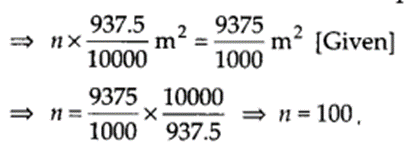
Thus, the required number of bricks = 100
Ex 13.1 Class 9 Maths Question 5.
A cubical box has each edge 10 cm and another cuboidal box is 12.5 cm long, 10 cm wide and 8 cm high.
(i) Which box has the greater lateral surface area and by how much?
(ii) Which box has the smaller total surface area and by how much?
Solution:
For the cubical box with edge (a) = 10 cm
Lateral surface area = 4a2 = 4 x 102 cm2
= 400 cm2
Total surface area = 6a2 = 6 x 102 cm2
= 600 cm2
For the cuboidal box with dimensions,
Length (l) = 12.5 cm,
Breadth (b) = 10 cm,
Height (h) = 8 cm
∴ Lateral surface area = 2[l + b] x h = 2[12.5 + 10] x 8 cm2 = 360 cm2
Total surface area => 2[lb + bh + hl]
=2[(12.5 x 10) + (10 x 8) + (8 x 12.5)] cm2
2[125 + 80 + 100] cm2
= 2[305] cm2
=>610 cm2
(i) A cubical box has the greater lateral surface area by (400 – 360) cm2 = 40 cm2.
(ii) Total surface area of a cubical box is smaller than the cuboidal box by (610 – 600) cm2 = 10 cm2.
Ex 13.1 Class 9 Maths Question 6.
A small indoor greenhouse (herbarium) is made entirely of glass panes (including base) held together with tape. It is 30 cm long, 25 cm wide and 25 cm high.
(i) What is the area of the glass?
(ii) How much of tape is needed for all the 12 edges?
Solution:
The herbarium is like a cuboid.
Here, length (l) = 30 cm,
breadth (b) = 25 cm,
height (h) = 25 cm
(i) Surface area of the herbarium (glass)
2[lb + bh + hl]
= 2[(30 x 25) + (25 x 25) + (25 x 30)] cm2 – 2[750 + 625 + 750] cm2
=>2[2125] cm2
4250 cm2
Thus, the required area of the glass = 4250 cm2
(ii) Total length of 12 edges = 4l + 4b + 4h
= 4(l + b + h)
4(30 + 25 + 25) cm
=4 x 80 cm = 320 cm
Thus, the required length of tape = 320 cm
Ex 13.1 Class 9 Maths Question 7.
Shanti Sweets Stalll was placing an order for making cardboard boxes for packing their sweets. Two sizes of boxes were required. The bigger of dimensions 25 cm x 20 cm x 5 cm and the smaller of dimensions 15 cm x 12 cm x 5 cm. For all the overlaps, 5% of the total surface area is required extra. If the cost of the cardboard is ₹4 for 1000 cm², find the cost of cardboard required for supplying 250 boxes of each kind.
Solution:
For bigger box:
Length (l) = 25 cm,
Breadth (b) = 20 cm,
Height (h) = 5 cm
Total surface area of a box = 2(lb + bh + hl)
2[(25 x 20) + (20 x 5) + (5 x t25)] cm2
2 [500 + 100 + 125] cm2
2[725] cm2
1450 cm2
Total surface area of 250 boxes = (250 x 1450) cm2 = 362500 cm2
For smaller box:
l = 15 cm, b = 12 cm, h = 5 cm
Total surface area of a box = 2 [lb + bh + hl]
= 2[(15 x 12) + (12 x 5) + (5 x 15)] cm2
= 2[180 + 60 + 75] cm2 = 2[315] cm2 = 630 cm2
∴ Total surface area of 250 boxes = (250 x 630) cm2 = 157500 cm2
Now, total surface area of both type of boxes = 362500 cm2 +157500 cm2 = 520000 cm2 Area for overlaps = 5% of [total surface area]
= 5100 x 520000 cm2 = 26000 cm2
∴ Total surface area of the cardboard required = [Total surface area of 250 boxes of each type] + [Area for overlaps]
= 520000 cm2 + 26000 cm2 = 546000 cm2
∵ Cost of 1000 cm2 cardboard = Rs. 4
∴ Cost of 546000 cm2 cardboard
= Rs.4×5460001000 = Rs. 2184
Ex 13.1 Class 9 Maths Question 8.
Parveen wanted to make a temporary shelter, for her car, by making a box-like structure with tarpaulin that covers all the four sides and the top of the car (with the front face as a flap which can be rolled up). Assuming that the stitching margins are very small and therefore negligible, how much tarpaulin would be required to make the shelter of height 2.5 m, with base dimensions 4 m x 3 m?
Solution:
Here, length (l) = 4 m,
breadth (b) = 3m
and height (h) = 2.5 m
The structure is like a cuboid.
∴ The surface area of the cuboid, excluding the base
=[Lateral surface area] + [Area of ceiling]
[2(l + b)h] + [lb]
= [2(4 + 3) x 2.5] m2 + [4 x 3] m2
= 35 m2 + 12 m2 = 47 m2
Thus, 47 m2 tarpaulin would be required.
Ex 13.2 Class 9 Maths Question 1.
The curved surface area of a right circular cylinder of height 14 cm is 88 cm2. Find the diameter of the base of the cylinder.
Solution:
Let r be the radius of the cylinder.
Here, height (h) = 14 cm and curved surface area = 88 cm2
Curved surface area of a cylinder = 2πrh
2πrh = 88
⇒ 2 x 227 x r x 14 = 88
⇒ r = 88×72×22×14 = 1 cm
∴ Diameter = 2 x r = (2 x 1) cm = 2 cm
Ex 13.2 Class 9 Maths Question 2.
It is required to make a closed cylindrical tank of height 1 m and base diameter 140 cm from a metal sheet. How many square metres of the sheet are required for the same?
Solution:
Here, height (h) = 1 m
Diameter of the base = 140 cm = 1.40 m
Radius (r) = 1.402m = 0.70 m
Total surface area of the cylinder = 2πr (h + r)
= 2 x 227 x 0.70(1 + 0.70)m2
2 x 22 x 0.10 x 1.70 m2
= 2 x 22 x 10100 x 170100m2
= 748100m2 = 7.48 m2
Hence, the required sheet = 7.48 m2
Ex 13.2 Class 9 Maths Question 3.
A metal pipe is 77 cm long. The inner ft diameter of a cross section is 4 cm, the outer diameter being 4.4 cm (see figure). Find its
(i) inner curved surface area.
(ii) outer curved surface area.
(iii) total surface area.

Solution:
Length of the metal pipe = 77 cm
It is in the form of a cylinder.
∴ Height of the cylinder (h) = 77 cm
Inner diameter = 4 cm
Inner radius (r) = 42 cm = 2 cm
Outer diameter = 4.4 cm
⇒ Outer radius (R) = 4.42 cm = 2.2 cm
(i) Inner curved surface area = 2πrh
= 2 x 227 x 2 x 77 cm2
= 2 x 22 x 2 x 11 cm2 = 968 cm2 (ii) Outer curved surface area = 2πRh
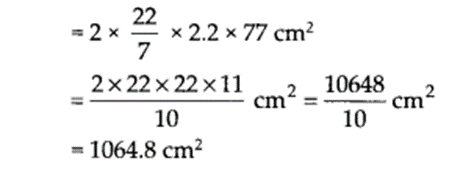
(iii)Total surface area = [Inner curved surface area] + [Outer curved surface area] + [Area of two circular ends]
= [2πrh] + [2πRh] + 2[π(R2 – r2)]
= [968 cm2] + [1064.8 cm2]
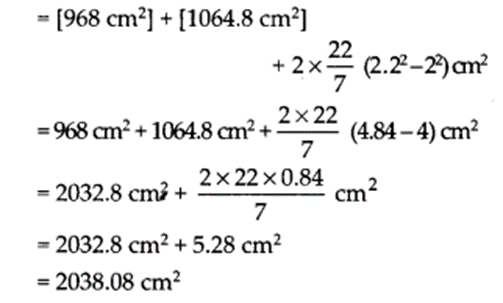
Ex 13.2 Class 9 Maths Question 4.
The diameter of a roller is 84 cm and its length is 120 cm. It takes 500 complete revolutions to move once over to level a playground. Find the area of the playground in m2.
Solution:
The roller is in the form of a cylinder of diameter = 84 cm
⇒ Radius of the roller(r) = 842 cm = 42 cm
Length of the roller (h) = 120 cm
Curved surface area of the roller = 2πrh
= 2 x 227 x 42 x 120 cm2
= 2 x 22 x 6 x 120 cm2 = 31680 cm2
Now, area of the playground levelled in one revolution of the roller = 31680 cm2
= 3168010000m2
∴ Area of the playground levelled in 500
revolutions = 500 x 3168010000m2 = 1584m2
Ex 13.2 Class 9 Maths Question 5.
A cylindrical pillar is 50 cm in diameter and 3.5 m in height. Find the cost of painting the curved surface of the pillar at the rate of ₹12.50 per m2 .
Solution:
Diameter of the pillar = 50 cm
∴ Radius (r) = 502m = 25 m = 14m
and height (h) = 3.5m
Curved surface area of a pillar = 2πrh
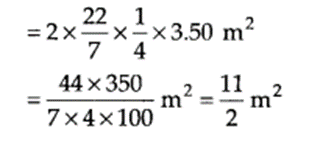
∴ Curved surface area to be painted = 112m2
∴ Cost of painting of 1 m2 pillar = Rs. 12.50
∴ Cost of painting of 112 m2 pillar
= Rs. ( 112 x 12.50 )
= Rs. 68.75.
Ex 13.2 Class 9 Maths Question 6.
Curved surface area of a right circular cylinder is 4.4 m2. If the radius of the base of the cylinder is 0.7 m, find its height.Curved surface area of a right circular cylinder is 4.4 m2. If the radius of the base of the cylinder is 0.7 m, find its height.
Solution:
Radius (r) = 0.7 m
Let height of the cylinder be h m
Curved surface area of a cylinder = 2πrh
= 2 x 227 x 710 x hm2
But the curved surface area is 4.4 m2. [Given]
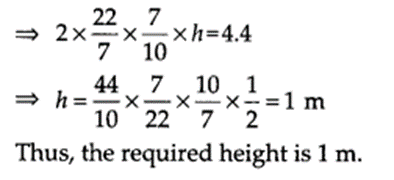
Ex 13.2 Class 9 Maths Question 7.
he inner diameter of a circular well is 3.5 m. It is 10 m deep. Find
(i) its inner curved surface area.
(ii) the cost of plastering this curved surface at the rate of ₹40 per m2.
Solution:
Hans Inner diameter of the well = 3.5 m
Radius of the well (r) = 3.52
Height of the well (h) = 10 m
(i) Inner curved surface area = 2πrh

(ii) Cost of plastering per m2 = Rs. 40
∴ Total cost of plastering the area 110 m2
= Rs. (110 x 40) = Rs. 4400
Ex 13.2 Class 9 Maths Question 8.
In a hot water heating system, there is a cylindrical pipe of length 28 m and diameter 5 cm. Find the total radiating surface in the system.
Solution:
USD Length of the cylindrical pipe (h) = 28 m
Diameter of the pipe = 5 cm
∴ Radius (r) = 52 cm = 5200 m
Curved surface area of a cylinder = 2πrh

Thus, the total radiating surface is 4.4 m2 .
Ex 13.2 Class 9 Maths Question 9.
Find
(i) the lateral or curved surface area of a closed cylindrical petrol storage tank that is 4.2 m in diameter and 4.5 m high.
(ii) how much steel was actually used, if 112 of the steel actually used was wasted in making the tank.
Solution:
The storage tank is in the form of a cylinder.
∴ Diameter of the tank = 4.2 m
⇒ Radius (r) = 4.22 = 2.1 m
Height (h) = 4.5 m
Now,
(i) Lateral (or curved) surface area of the tank = 2πrh
= 2 x 227 x 2.1 x 4.5 m2
= 2 x 22 x 0.3 x 4.5 m2 59.4 m2 (ii) Total surface area of the tank = 2πr(r + h)
= 2 x 227 x 2.1(2.1 + 4.5)m2
= 44 x 0.3 x 6.6 m2 = 87.13 m2
Let actual area of the steel used be x m2
∴ Area of steel that was wasted = 112 x x m
= x12m2
Area of steel used = x – x12 m2


Thus, the required area of the steel that was actually used is 95.04 m2.
Ex 13.2 Class 9 Maths Question 10.
In figure, you see the frame of a lampshade. It is to be covered with a decorative cloth. The frame has a base diameter of 20 cm and height of 30 cm. A margin of 2.5 cm is to be given for folding it over the top and bottom of the frame. Find how much cloth is required for covering the lampshade
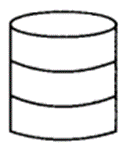
Solution:
The lampshade is in the form of a cylinder,
where radius (r) = 202 cm = 10 cm
and height = 30 cm.
A margin of 2.5 cm is to be added to the top and bottom of the frame.
∴ Total height of the cylinder, (h)
= 30 cm + 2.5 cm + 2.5 cm = 35 cm
Now, curved surface area = 2πrh
= 2 x 227 x 10 x 35 cm2
= 2200 cm2
Thus, the required area of the cloth = 2200 cm2
Ex 13.2 Class 9 Maths Question 11.
The students of a Vidyalaya were asked to participate in a competition for making and decorating penholders in the shape of a cylinder with a base, using cardboard. Each penholder was to be of radius 3 cm and height 10.5 cm. The Vidyalaya was to supply the competitors with cardboard. If there were 35 competitors, how much cardboard was required to be bought for the competition?
Solution:
Here, the penholders are in the form of cylinder.
Radius of a penholder (r) = 3 cm
Height of a penholder (h) = 10.5 cm
Since, a penholder must be open from the top.
Now, surface area of a penholder = [Lateral surface area] + [Base area]
= [2πrh] + [πr2]

∴ Surface area of 35 penholders
= 35 x 15847 cm2 = 7920 cm2
Thus, 7920 cm2 of cardboard was required to be bought.
Ex 13.3 Class 9 Maths Question 1.
Diameter of the base of a cone is 10.5 cm and its slant height is 10 cm. Find its curved surface area.
Solution:
Here, diameter of the base = 10.5 cm
⇒ Radius (r) = 10.52 cm
and slant height (l) =10 cm
Curved surface area of the cone = πrl
= 227 x 10.52 x 10cm2
= 11 x 15 x 1 cm2 = 165cm2 Ex 13.3
Class 9 Maths Question 2.
Find the total surface area of a cone, if its slant height is 21 m and diameter of its base is 24 m.
Solution:
Here, diameter = 24 m 24
∴ Radius (r) = 242 m = 12 m
and slant height (l) = 21 m
∴ Total surface area of a cone = πr(r +1)

Ex 13.3 Class 9 Maths Question 3.
Curved surface area of a cone is 308 cm² and its slant height is 14 cm. Find
(i) radius of the base and
(ii) total surface area of the cone.
Solution:
Here, curved surface area = πrl = 308 cm2
Slant height (l) = 14 cm
(i) Let the radius of the base be ‘r’ cm
∴ πrl = 308 ⇒ 227 x r x 14 = 308
r = 308×722×14 = 7cm
Thus, radius of the cone is 7 cm
(ii) Base area = πr2 = 227 x 72 cm2
= 22 x 7 cm2 = 154 cm2
and curved surface area = 308 cm2 [Given]
∴ Total surface area of the cone
= [Curved surface area] + [Base area] = 308 cm2 + 154 cm2
= 462 cm2
Ex 13.3 Class 9 Maths Question 4.
A conical tent is 10 m high and the radius of its base is 24 m. Find
(i) slant height of the tent.
(ii) cost of the canvas required to make the tent, if the cost of 1 m2 canvas is ₹70.
Solution:
Here, height of the tent (h) = 10 m
Radius of the base (r) = 24 m
(i) The slant height, l = r2−h2−−−−−−√
= 242+102−−−−−−−−√ m = 576+100−−−−−−−−√ m = 676−−−√ m = 26m
Thus, the required slant height of the tent is 26 m. (ii) Curved surface area of the cone = πrl
∴ Area of the canvas required
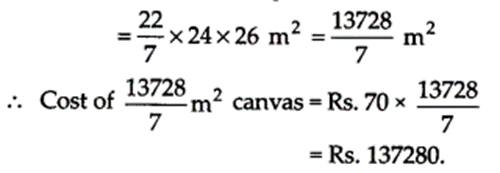
Ex 13.3 Class 9 Maths Question 5.
What length of tarpaulin 3 m wide will be required to make conical tent of height 8 m and base radius 6m? Assume that the extra length of material that will be required for stitching margins and wastage in cutting is approximately 20 cm. (Use π = 3.14)
Solution:
Here, base radius (r) = 6 m
Height(h) = 8m
∴ Slant height (l) = r2−h2−−−−−−√ = 62−82−−−−−−√ m
= 36+64−−−−−−√ m
= 100−−−√m = 10 m
Now, curved surface area = πrl
= 3.14 x 6 x 10m2
= 314100 x 6 x 10 m2 = 1884 m2
Thus, area of the tarpaulin required to make the tent = 188.4 m2
Let the length of the tarpaulin be L m
Length x Breadth = 188.4
⇒ L x 3 = 188.4 ⇒ L = 188.43 = 62.8
Extra length of tarpaulin required for margins = 20cm = 20100m = 0.2m
Thus, total length of tarpaulin required = 62.8 m + 0.2 m = 63 m
Ex 13.3 Class 9 Maths Question 6.
The slant height and base diameter of a conical tomb are 25 m and 14 m respectively. Find the cost of white-washing its curved surface at the rate of ₹ 210 per 100 m2 .
Solution:
Here, base radius (r) = 142 m = 7 m
Slant height (l) = 25 m
∴ Curved surface area = πrl
= 227 x 7 x 25 m2 = 550 m2
Cost of white-washing for 100 m2 area = Rs. 210
∴ Cost of white-washing for 550 m2 area
= Rs. 210100 x 550 = Rs. 1155
Ex 13.3 Class 9 Maths Question 7.
A joker’s cap is in the form of a right circular cone of base radius 7 cm and height 24 cm. Find the area of the sheet required to make 10 such caps.
Solution:
Radius of the base (r) = 7 cm and height (h) = 24 cm
Slant height (l) = h2−r2−−−−−−√ = 242−72−−−−−−−√cm
= 576+49−−−−−−−√cm = 625−−−√ cm = 25 cm
∴Lateral surface area = πrl = 227 x 7 x 25 cm2 = 550 cm2
∴ Lateral surface area of 10 caps = 10 x 550 cm2
= 5500 cm2
Thus, the required area of the sheet = 5500 cm2
Ex 13.3 Class 9 Maths Question 8.
A bus stop is barricaded from the remaining part of the road, by using 50 hollow cones made of recycled cardboard. Each cone has a base diameter of 40 cm and height 1 m. If the outer side of each of the cones is to be painted and the cost of painting is ₹12 per m², what will be the cost of painting all these cones? (Use π = 3.14 and take 104−−−√ = 1.02)
Solution:
Diameter of the base = 40cm
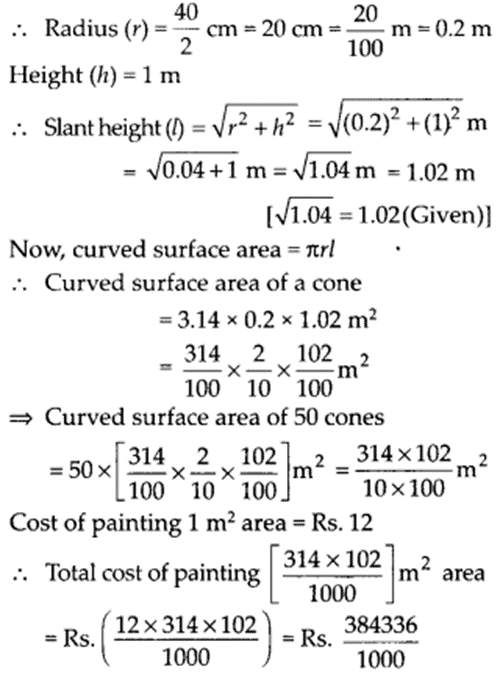
= Rs. 384.336 = Rs. 384.34 (approx.)
Thus, the required cost of painting is Rs. 384.34 (approx.).
Ex 13.4 Class 9 Maths Question 1.
Find the surface area of a sphere of radius
(i) 10.5 cm
(ii) 5.6 cm
(iii) 14 cm
Solution:
(i) Here, r = 10.5 cm
Surface area of a sphere = 4πr2

(ii) Here, r = 5.6 cm
Surface area of a sphere = 4πr2
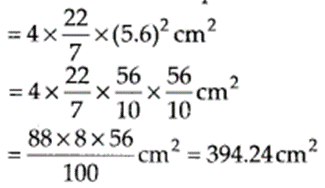
iii) Here, r = 14 cm
Surface area of a sphere = 4πr2
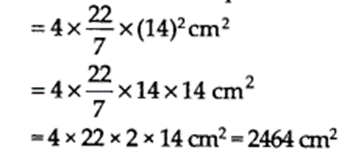
Ex 13.4 Class 9 Maths Question 2.
Find the surface area of a sphere of diameter
(i) 14 cm
(ii) 21 cm
(iii) 3.5 m
Solution:
(i) Here, diameter = 14 cm
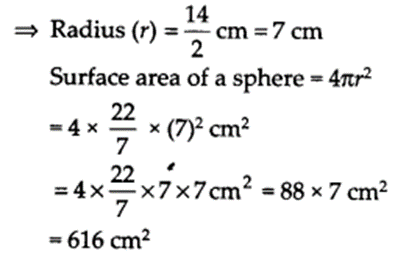
(ii) Here, diameter = 21 cm
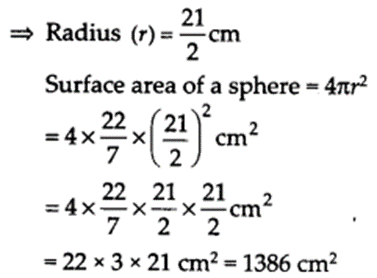
(iii) Here, diameter = 3.5 m
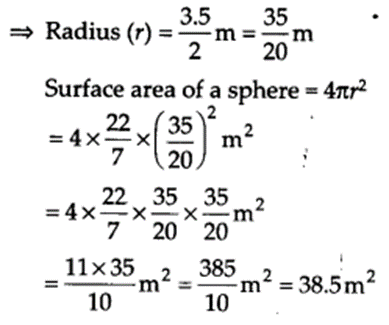
Ex 13.4 Class 9 Maths Question 3.
Find the total surface area of a hemisphere of radius 10 cm. (Use π = 3.14)
Solution:
Here, radius (r) = 10 cm
Total surface area of hemisphere = 3πr2
= 3 x 3.14 x 10 x 10 cm2 = 942 cm2
Ex 13.4 Class 9 Maths Question 4.
The radius of a spherical balloon increases from 7 cm to 14 cm as air is being pumped into it. Find the ratio of surface areas of the balloon in the two cases.
Solution:
Find the ratio of surface areas of the balloon in the two cases.
BSD Case I: When radius (r1) = 7 cm
Surface area = 4πr12 = 4 x 227 x (7) cm2
= 4 x 22 x 7 cm2 = 616 cm2
Case II: When radius (r2) = 14 cm2
Surface area = 4πr22=4 x 227 x (14)2 cm2
= 4 x 22 x 14 x 2 cm2 = 2464 cm2
∴ The required ratio = 6162464 = 14 or 1 : 4
Ex 13.4 Class 9 Maths Question 5.
A hemispherical bowl made of brass has inner diameter 10.5 cm. Find the cost of tin-plating it on the inside at the rate of ₹16 per 100 cm².
Solution:
Inner diameter of the hemispherical bowl = 10.5 cm
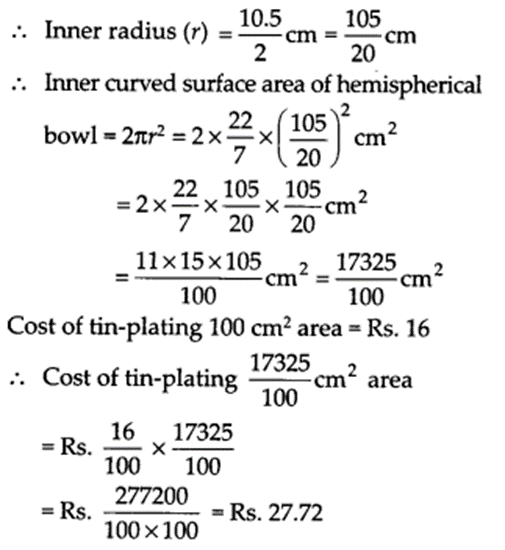
Download Mennta App and get access to free video lectures and hand crafted notes.